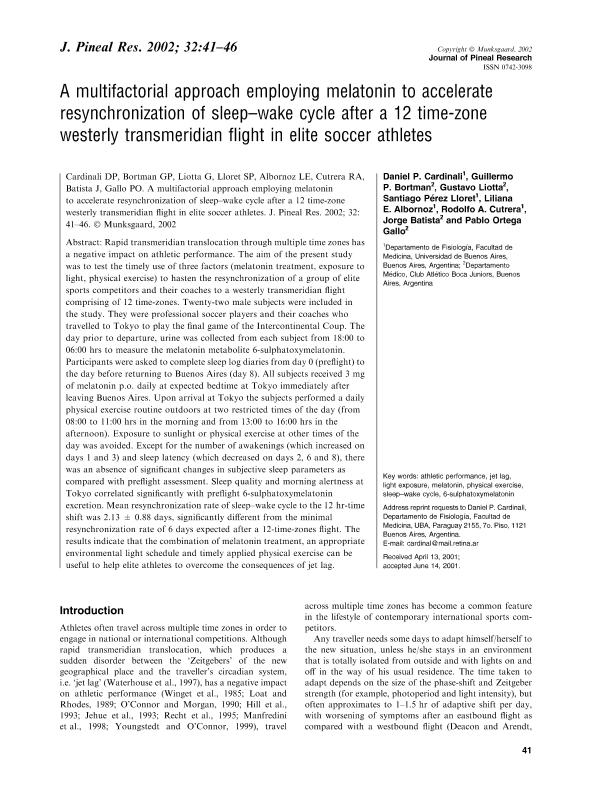Mostrar el registro sencillo del ítem
dc.contributor.author
Cardinali, Daniel Pedro

dc.contributor.author
Bortman, Guillermo

dc.contributor.author
Liotta, G.
dc.contributor.author
Perez Lloret, Santiago

dc.contributor.author
Albornoz Britos, Laura Elena

dc.contributor.author
Cutrera, Rodolfo Angel

dc.contributor.author
Batista, Julián Alberto

dc.contributor.author
Ortega Gallo, P.
dc.date.available
2022-02-18T12:17:03Z
dc.date.issued
2002-03
dc.identifier.citation
Cardinali, Daniel Pedro; Bortman, Guillermo; Liotta, G.; Perez Lloret, Santiago; Albornoz Britos, Laura Elena; et al.; A multifactorial approach employing melatonin to accelerate resynchronization of sleep-wake cycle after a 12 time-zone westerly transmeridian flight in elite soccer athletes; Wiley Blackwell Publishing, Inc; Journal of Pineal Research; 32; 1; 3-2002; 41-46
dc.identifier.issn
0742-3098
dc.identifier.uri
http://hdl.handle.net/11336/152282
dc.description.abstract
Rapid transmeridian translocation through multiple time zones has a negative impact on athletic performance. The aim of the present study was to test the timely use of three factors (melatonin treatment, exposure to light, physical exercise) to hasten the resynchronization of a group of elite sports competitors and their coaches to a westerly transmeridian flight comprising of 12 time-zones. Twenty-two male subjects were included in the study. They were professional soccer players and their coaches who travelled to Tokyo to play the final game of the Intercontinental Coup. The day prior to departure, urine was collected from each subject from 18:00 to 06:00 hrs to measure the melatonin metabolite 6-sulphatoxymelatonin. Participants were asked to complete sleep log diaries from day 0 (preflight) to the day before returning to Buenos Aires (day 8). All subjects received 3 mg of melatonin p.o. daily at expected bedtime at Tokyo immediately after leaving Buenos Aires. Upon arrival at Tokyo the subjects performed a daily physical exercise routine outdoors at two restricted times of the day (from 08:00 to 11:00 hrs in the morning and from 13:00 to 16:00 hrs in the afternoon). Exposure to sunlight or physical exercise at other times of the day was avoided. Except for the number of awakenings (which increased on days 1 and 3) and sleep latency (which decreased on days 2, 6 and 8), there was an absence of significant changes in subjective sleep parameters as compared with preflight assessment. Sleep quality and morning alertness at Tokyo correlated significantly with preflight 6-sulphatoxymelatonin excretion. Mean resynchronization rate of sleep-wake cycle to the 12 hr-time shift was 2.13 ± 0.88 days, significantly different from the minimal resynchronization rate of 6 days expected after a 12-time-zones flight. The results indicate that the combination of melatonin treatment, an appropriate environmental light schedule and timely applied physical exercise can be useful to help elite athletes to overcome the consequences of jet lag.
dc.format
application/pdf
dc.language.iso
eng
dc.publisher
Wiley Blackwell Publishing, Inc

dc.rights
info:eu-repo/semantics/openAccess
dc.rights.uri
https://creativecommons.org/licenses/by-nc-sa/2.5/ar/
dc.subject
6-SULPHATOXYMELATONIN
dc.subject
ATHLETIC PERFORMANCE
dc.subject
JET LAG
dc.subject
LIGHT EXPOSURE
dc.subject
MELATONIN
dc.subject
PHYSICAL EXERCISE
dc.subject
SLEEP-WAKE CYCLE
dc.subject.classification
Fisiología

dc.subject.classification
Medicina Básica

dc.subject.classification
CIENCIAS MÉDICAS Y DE LA SALUD

dc.title
A multifactorial approach employing melatonin to accelerate resynchronization of sleep-wake cycle after a 12 time-zone westerly transmeridian flight in elite soccer athletes
dc.type
info:eu-repo/semantics/article
dc.type
info:ar-repo/semantics/artículo
dc.type
info:eu-repo/semantics/publishedVersion
dc.date.updated
2021-12-03T20:48:48Z
dc.journal.volume
32
dc.journal.number
1
dc.journal.pagination
41-46
dc.journal.pais
Reino Unido

dc.journal.ciudad
Londres
dc.description.fil
Fil: Cardinali, Daniel Pedro. Universidad de Buenos Aires. Facultad de Medicina; Argentina. Consejo Nacional de Investigaciones Científicas y Técnicas. Oficina de Coordinación Administrativa Houssay; Argentina
dc.description.fil
Fil: Bortman, Guillermo. No especifíca;
dc.description.fil
Fil: Liotta, G.. No especifíca;
dc.description.fil
Fil: Perez Lloret, Santiago. Consejo Nacional de Investigaciones Científicas y Técnicas. Oficina de Coordinación Administrativa Houssay; Argentina. Universidad de Buenos Aires. Facultad de Medicina; Argentina
dc.description.fil
Fil: Albornoz Britos, Laura Elena. Consejo Nacional de Investigaciones Científicas y Técnicas. Oficina de Coordinación Administrativa Houssay; Argentina. Universidad de Buenos Aires. Facultad de Medicina; Argentina
dc.description.fil
Fil: Cutrera, Rodolfo Angel. Universidad de Buenos Aires. Facultad de Medicina; Argentina. Consejo Nacional de Investigaciones Científicas y Técnicas. Oficina de Coordinación Administrativa Houssay; Argentina
dc.description.fil
Fil: Batista, Julián Alberto. No especifíca;
dc.description.fil
Fil: Ortega Gallo, P.. No especifíca;
dc.journal.title
Journal of Pineal Research

dc.relation.alternativeid
info:eu-repo/semantics/altIdentifier/doi/http://dx.doi.org/10.1034/j.1600-079x.2002.10820.x
dc.relation.alternativeid
info:eu-repo/semantics/altIdentifier/url/https://onlinelibrary.wiley.com/doi/abs/10.1034/j.1600-079x.2002.10820.x
Archivos asociados
